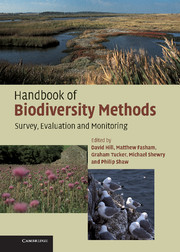Book contents
- Frontmatter
- Contents
- Preface
- Acknowledgements
- Part I Planning
- Part II Habitats
- Part III Species
- 9 Introduction to species assessment
- 10 General principles and methods for species
- 11 Fungi
- 12 Lichens
- 13 Bryophytes
- 14 Aquatic macrophytes and algae
- 15 Vascular plants
- 16 Dragonflies and damselflies
- 17 Butterflies
- 18 Moths
- 19 Other terrestrial invertebrates
- 20 Aquatic invertebrates
- 21 Fish
- 22 Amphibians
- 23 Reptiles
- 24 Birds
- 25 Bats
- 26 Other mammals
- Appendix 1 Monitoring and reporting obligations under international conservation agreements
- Appendix 2 Relationship between BAP Priority Habitat and Broad Habitat categories and Habitats Directive nomenclature
- Appendix 3 Annotated list of key references for plant identification
- Appendix 4 Determining appropriate quadrat size for vegetation sampling
- Appendix 5 The relocation of permanent plots
- Appendix 6 Equipment required for undertaking different types of survey
- Recommended sources of further information
- References
- Glossary
- Index
15 - Vascular plants
Published online by Cambridge University Press: 01 September 2010
- Frontmatter
- Contents
- Preface
- Acknowledgements
- Part I Planning
- Part II Habitats
- Part III Species
- 9 Introduction to species assessment
- 10 General principles and methods for species
- 11 Fungi
- 12 Lichens
- 13 Bryophytes
- 14 Aquatic macrophytes and algae
- 15 Vascular plants
- 16 Dragonflies and damselflies
- 17 Butterflies
- 18 Moths
- 19 Other terrestrial invertebrates
- 20 Aquatic invertebrates
- 21 Fish
- 22 Amphibians
- 23 Reptiles
- 24 Birds
- 25 Bats
- 26 Other mammals
- Appendix 1 Monitoring and reporting obligations under international conservation agreements
- Appendix 2 Relationship between BAP Priority Habitat and Broad Habitat categories and Habitats Directive nomenclature
- Appendix 3 Annotated list of key references for plant identification
- Appendix 4 Determining appropriate quadrat size for vegetation sampling
- Appendix 5 The relocation of permanent plots
- Appendix 6 Equipment required for undertaking different types of survey
- Recommended sources of further information
- References
- Glossary
- Index
Summary
There are a series of general problems that can be encountered when monitoring vascular plants, not all of which will apply in every case. The type of plant being surveyed, the methods used and the recorders can all affect the results (Rich & Woodruff, 1990).
Defining an individual
Defining an individual plant can be a problem; opinions differ between botanists. With annuals or biennials there are rarely difficulties as their growth forms are generally simple. Perennials have more varied growth forms. If the species grows in dense clumps, the clumps might be composed of one or more individuals, and species spreading by stolons or rhizomes may form single or mixed patches of clones. Clonal perennials may also fragment, resulting in two or more parts of the original plant. Trees tend to be counted as individual trunks, although some trees such as Aspen Populus tremula spread by suckers.
Alternatively, proxy measures of abundance can be used such as the number of ramets or shoots, or percentage cover, rather than the number of individuals.
The method by which an individual is defined should be clearly stated at the outset of survey and monitoring, so that this can be followed subsequently.
Defining populations
The definition of the extent of a population varies between botanists. It is possible to delimit populations by compartment, habitat, site, ownership or other boundaries, distance to nearest neighbouring populations, or by 1 km square, etc.
- Type
- Chapter
- Information
- Handbook of Biodiversity MethodsSurvey, Evaluation and Monitoring, pp. 303 - 321Publisher: Cambridge University PressPrint publication year: 2005
- 2
- Cited by



